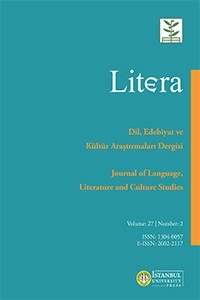Memory Space in the Works of Patrick Modiano
The present work aims to study first the repetitive elements in the content and in the narration and then the representation of the city as part of literary discourse through the three novels L’Horizon, L’Herbe des nuits, Pour que tu ne te perdes pas dans le quartier of 2014 Nobel Laureate in Literature Jean Patrick Modiano. Lost women, amateur research, diaries and journeys, the mechanism of remembering or the omnipresent forgetting are revealed as leitmotifs in P. Modiano’s writing. The narrators particularly specify the space-time frameworks using objects, testimonies, facts and personal memory. In each story, the reader experiences a triple temporal sequence (childhood, youth and adult), and a mobile space that becomes the x-ray of Paris. The writer draws an emotional / romantic map of the city through memories, walks and surveys that take the form of introspection not only for the protagonists but also for society itself. This article seeks to highlight the presentation of places, their transformations, effect, and function at the cognitive level. We propose a narratological and intertextual reading of the work of P. Modiano.
Keywords:
City, space, oblivion, memory intertextuality,
___
- Barthes, R. (2015). La préparation du roman. Paris : Seuil.
- Blanckeman, B. (2009). Lire Patrick Modiano. Paris : Armand Colin.
- Bourneuf, R. & Ouellet, R. (1989). L’Univers du roman. Paris : PUF.
- Dällenbach, L. (1976). Intertexte et autotexte. Poétique, revue de théorie et d’analyse littéraires, 27, 282-296.
- Entretien avec Jérôme Garcin, Le Nouvel Observateur, 27 septembre 2007, https://bibliobs.nouvelobs.com/romans/20070926.BIB0104/paris-ma-ville-interieure.html, consulté le 10 septembre 2019.
- Genette, G. (1982). Palimpsestes. La littérature au second degré. Paris : Seuil.
- Martel, M. (2005). Les notions d’intertextualité et d’intratextualité dans les théories de la réception. Protée, 33 (1), 93-102. https://doi.org/10.7202/012270ar, consulté le 17 décembre 2019.
- Modiano, P. (2010). L’Horizon. Paris : Gallimard.
- __________ (2012). L’Herbe des nuits. Paris : Gallimard.
- __________ (2014). Pour que tu ne te perdes pas dans le quartier. Paris : Gallimard.
- __________ (2015). Discours à l’Académie suédoise. Paris : Gallimard.
- Mura-Brunel, A. (2017). Les lieux du trouble : Lecture de trois romans de Patrick Modiano. Paris : Lavoir Saint-Martin.
- Nora, P. Les lieux de mémoire. Sous la direction de. 3 tomes : t. 1 La République (1984), t. 2 La Nation (1986), t. 3 Les France (1992), Paris : Gallimard.
- Pavel, T. (1988). Univers de la fiction. Paris : Seuil.
- Popovic, P. (1988). De la ville à sa littérature. Études françaises, 24 (3), 109-121.
- Robin, R. (2012). Le Paris toujours déjà perdu de Patrick Modiano », In Heck, M. & Guidée, M. (Ed.), Cahier de l’Herne. Patrick Modiano, Paris : L’Herne.
- Saint-Gelais, R. (2011). Fictions transfuges :la transfictionnalité et ses enjeux. Paris : Seuil, 2011.
- Schlesser, G. (2019). Paris dans les pas de Patrick Modiano. Paris : Parigramme.
- WanderWolk, W. (1997). Rewriting the past: Memory, history and narration in the novels of Patrick Modiano. Amsterdam : Rodopi.
- Başlangıç: 1954
- Yayıncı: İstanbul Üniversitesi
Sayıdaki Diğer Makaleler
